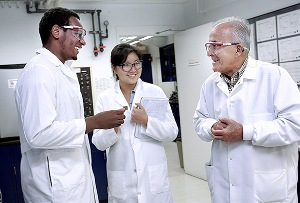Nov 15 2013
Princeton University freshmen Michal Prenovitz and Matine Yuksel carefully placed a small wood sample in a machine designed to crush objects with thousands of pounds of force. As the machine's steel jaws slowly squeezed, Professor Ilhan Aksay rolled up a few sheets of paper and turned to the students gathered nearby.
 Aksay discusses experimental results with students Austin Pruitt and Serena Zheng.
Aksay discusses experimental results with students Austin Pruitt and Serena Zheng.
"If I do this," he said, squeezing the rolled tube of papers in the middle, "the tube bounces back — unless I flatten it completely."
He switched his hands to the ends of the tube.
"But if I stress the ends, nothing happens until suddenly it buckles and there is permanent damage," he said. "The former is akin to stressing wood in a direction perpendicular to its cell walls. In the latter, the stress is applied in the same direction as the cell walls."
For the next hour, the 10 students crushed, bent and broke samples of different types of wood in Aksay's research laboratory. They measured the force that damaged the samples and peered through microscopes to analyze how the stress affected the blocks' internal structures.
For nearly 10 years, Aksay, a professor of chemical and biological engineering, has introduced students in his freshman seminar, "Materials World," to the everyday matter that makes up the foundation of civilization. In the course, designated as the Donald P. Wilson '33 and Edna M. Wilson Freshman Seminar, the students begin by analyzing the materials that helped launch civilization. The students study materials such as simple mud and adobe bricks, fired ceramics and biologically produced materials such as wood. As the semester progresses, they move through more complex materials, ending with electrically conducting polymers and even the construction of a lithium ion battery.
"My goal is to teach them about the fundamental materials that we have around us," Aksay said. "I want to give them answers to some of the questions that, one day, they may get from their children."
Along the way, Aksay introduces the students to lab techniques. The freshmen spend half of each class in a seminar discussion and then move to Aksay's lab, or the electron microscope at Bowen Hall, to apply what they have learned. For students who don't plan on pursuing a science degree, it offers hands-on experience in the lab. Science and engineering majors get an early chance to use state-of-the-art equipment.
"From talking to my friends at other schools, it's extremely rare for a freshman to get such a small class with high exposure to advanced equipment," said Austin Pruitt, who plans to major in mechanical and aerospace engineering. He said the seminar, which includes a mix of students studying science and other disciplines, is straightforward enough "so that everyone can understand it, but complex enough so that it is new knowledge for everyone in the class."
Aksay points out that the ages of human development are named for basic materials — stone, bronze, iron — and the class follows that organizational structure. In initial experiments, students made and examined mud bricks. They compared the strength and toughness of the mud bricks with sintered bricks, which have been fired in a kiln, and adobe bricks, in which straw is mixed with the mud. In those simple experiments, the students traversed thousands of years of technological history.
"The transition from mud bricks to sintered bricks took about 6,000 years," Aksay said. "Why? Because of technological development — you have to have furnaces. Adobe needed the agricultural revolution. Without hay, you cannot have the accident of mixing mud with straw."
Aksay asked what the students had observed about the various types of bricks, and why the material strengthened with heating.
"The form remains the same, but the chemical structure within the brick changes as you heat it," said Serena Zheng.
Aksay explained that high temperatures inside the kiln transform the clay at the molecular level.
"Clay becomes something different when you exceed 600 degrees centigrade," he said. "Crystals form like needles within a high temperature liquid that becomes glass when cooled. These needles start locking up and the object becomes stronger and stronger. The more you heat it, the higher the number of crystals."
Aksay himself is at the forefront of engineering based on the new material graphene, which is a one-atom-thick form of carbon. Graphene's remarkable characteristics, including strength, flexibility, and conductivity, have promised to open new areas of electronics such as flexible electronics and power systems. But until relatively recently, the material was extremely difficult to separate into thin sheets outside a laboratory.
Several years ago, Professor Robert Prud'homme, also in the chemical and biological engineering department, and Aksay developed a technique that uses an acid bath to oxidize graphite and a subsequent very rapid heating to efficiently create thin sheets of graphene. This patented method offers a way for engineers to develop widespread industrial uses for graphene.
John Lettow, who graduated from Princeton in 1995 with a degree in chemical engineering, has since formed a company, Vorbeck Materials, to develop new products — such as electrically conductive ink for printed circuits — based on the technology.
"Getting to have such close interactions with world-renowned faculty such as Ilhan, even as an undergraduate at Princeton, is a tremendous experience that stays with you throughout your career," Lettow said. "Though they may not fully realize it yet, these students are exceptionally lucky. I envy their time in Ilhan's class."
Aksay said the purpose of the seminar is not to develop the next great technical breakthrough but to expose a broad range of students to the fascination of science.
"I try to mix the science with fun," he said. "My goal is to teach students, whether they are interested in science or not, things that they will remember many decades from now."
Source: http://www.princeton.edu/